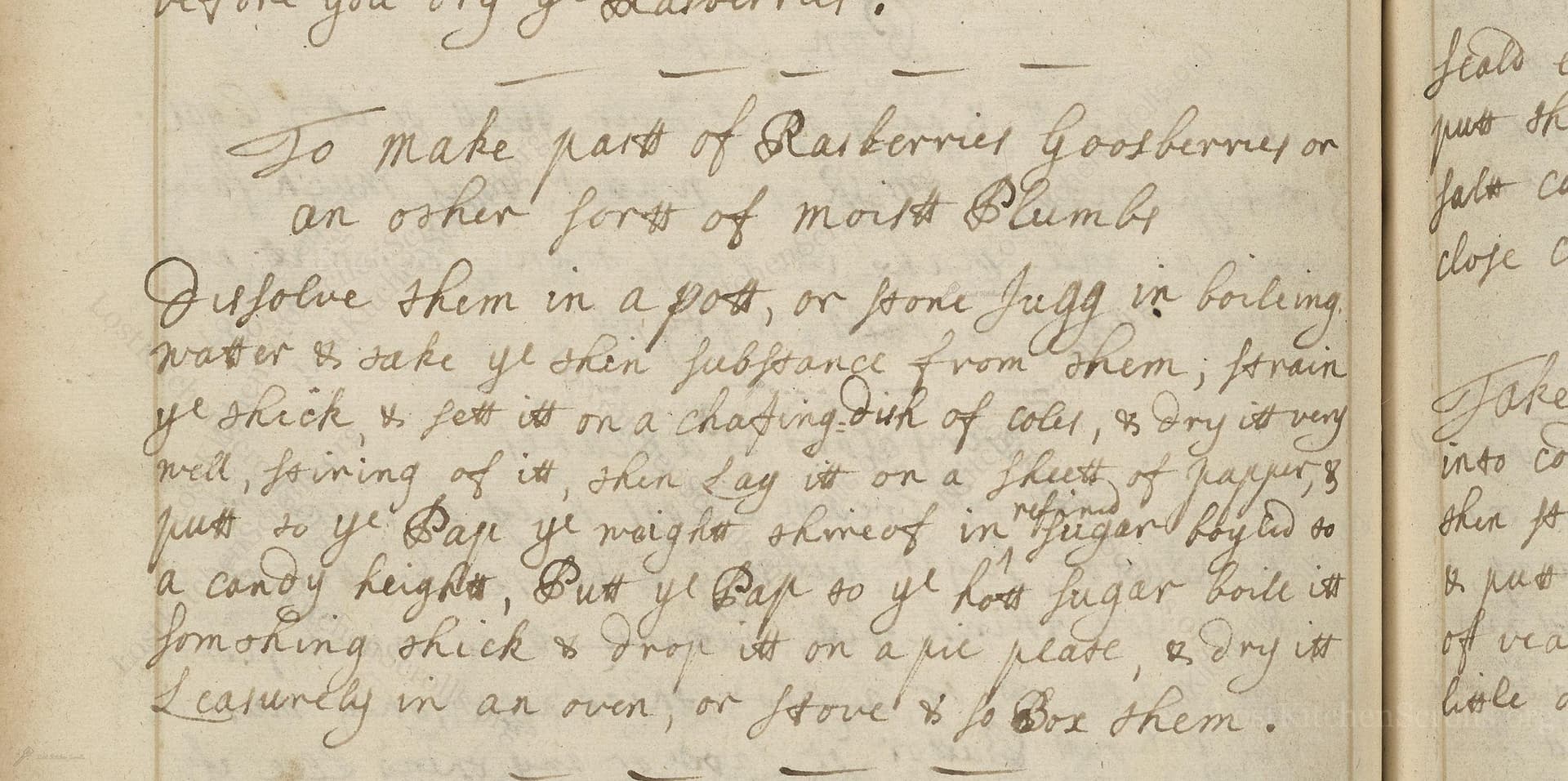To Make Past Of Rasberries Goosberries Or An Other Sort Of Moist Plumbs
From the treasured pages of Receipt book of Mary Hookes
Written by Mary Hookes

To Make Past Of Rasberries Goosberries Or An Other Sort Of Moist Plumbs
"Disolve them in a post, or some Jugg in boiling watter & take ye substance from them; strain ye thick, & sett it on a chassing dish of coles, & dry it very well, joining of it & then lay it on a sheett of papper, & putt so ye pap to ye weight thereof in suger boyld to a candy height, & drop it on a pie peate, & dry it something thick Leasurely in an oven, or stove & so Box them."
Note on the Original Text
The recipe is written in the free-flowing, unstandardized language of the late 1600s, with phonetic and dialectical spellings like 'suger' for sugar and 'jugg' for jug. Quantities are mostly proportional (fruit paste to sugar, by weight), with much left to the cook's judgment. Instructions are given as a sequence of actions rather than precise steps, reflecting a culture where cooks learned from demonstration, not detailed manuals. Modern equivalents—such as boiling sugar to 120-125°C—translate the original 'to a candy height' for contemporary clarity.

Title
Receipt book of Mary Hookes (1700)
You can also click the book image above to peruse the original tome
Writer
Mary Hookes
Era
1700
Publisher
Unknown
Background
A delightful voyage into the kitchens of the late 17th and early 18th centuries, this book teems with forgotten flavors, aromatic recipes, and the elegant wisdom of early modern cookery. A treasure trove for culinary adventurers craving a taste of the past!
Kindly made available by
Folger Shakespeare Library
This recipe comes from the late 17th to early 18th century, a time when fruit preservation was both a culinary art and a necessity, before the age of refrigeration. Women like Mary Hookes recorded such recipes to capture fleeting seasonal flavors and create sweetmeats for the household and guests. The preparation of fruit pastes and candies reflected the elegant, labor-intensive practices of the English gentry, who prized such treats as luxuries on the dessert table.

The cook would have used a 'post' (pot) or jug to heat the fruit, with an open fire or chafing dish of hot coals as a heat source. A strainer or fine cloth was essential for extracting the smooth purée. The drying stage called for sheets of strong paper (the forerunner to our modern parchment) placed in a gentle oven or purpose-built drying stove. Weighing was done with simple household scales or balancing against standardized weights. The sugar would be boiled in a sturdy pan, watched closely for the right temperature or 'candy height.'
Prep Time
20 mins
Cook Time
2 hrs 30 mins
Servings
20
We've done our best to adapt this historical recipe for modern kitchens, but some details may still need refinement. We warmly welcome feedback from fellow cooks and culinary historians — your insights support the entire community!
Ingredients
- 1 lb 2 oz raspberries, gooseberries, or plums (can substitute with other soft stone fruits if needed)
- Enough boiling water to cover the fruit (about 1 cup, as needed)
- 1 lb 2 oz granulated sugar (white), or a substitute such as caster sugar
Instructions
- Begin by gently simmering raspberries, gooseberries, or plums (or any moist stone fruit) in a saucepan with enough boiling water to soften them thoroughly.
- Once the fruit breaks down, press it through a fine sieve or cheesecloth to obtain a thick, smooth purée.
- Place the purée in a wide pan over gentle heat and stir frequently to evaporate excess moisture, thickening the mixture to a paste.
- Weigh the resulting fruit paste, then measure out an equal weight of granulated sugar.
- In a clean saucepan, heat the sugar with just enough water to dissolve it, then boil until it reaches the 'candy height'—about 250-255°F (firm-ball stage).
- Stir the hot sugar syrup into the fruit paste until well combined.
- Using a spoon, drop small rounds of the mixture onto a parchment-lined baking tray.
- Dry these drops slowly in a low oven (about 160°F) or dehydrator until they are set but still slightly pliable.
- Once cooled, store them layered between parchment in an airtight container.
Estimated Calories
90 per serving
Cooking Estimates
You will spend about 20 minutes getting the fruit ready, then simmering and thickening takes around 30 minutes. Making the sugar syrup and combining it with the fruit finishes in about 15 minutes. Drying in the oven can take 2 to 3 hours. Each serving has about 90 calories, and the recipe makes roughly 20 pieces.
As noted above, we have made our best effort to translate and adapt this historical recipe for modern kitchens, taking into account ingredients nowadays, cooking techniques, measurements, and so on. However, historical recipes often contain assumptions that require interpretation.
We'd love for anyone to help improve these adaptations. Community contributions are highly welcome. If you have suggestions, corrections, or cooking tips based on your experience with this recipe, please share them below.
Join the Discussion
Rate This Recipe
Dietary Preference
Main Ingredients

Den Bockfisch In Einer Fleisch Suppen Zu Kochen
This recipe hails from a German manuscript cookbook compiled in 1696, a time whe...

Die Grieß Nudlen Zumachen
This recipe comes from a rather mysterious manuscript cookbook, penned anonymous...

Ein Boudain
This recipe comes from an anonymous German-language manuscript cookbook from 169...

Ein Gesaltzen Citroni
This recipe, dating from 1696, comes from an extensive anonymous German cookbook...
Browse our complete collection of time-honored recipes



